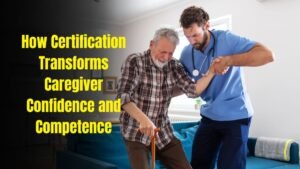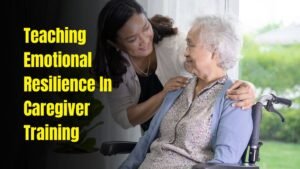A perfect storm—rapid population aging, workforce shortages, and rising complexity of care—means caregivers (family, community health workers, nursing assistants, and nurses) need better training delivered faster and more flexibly.
The latest workforce data show significant nursing shortages and uneven training capacity worldwide, pushing systems to rethink how caregivers are prepared for practice.
The World Health Organization’s 2025 nursing workforce report underscores the scale and urgency of re-skilling, up-skilling, and retaining talent into 2030.
The answer isn’t “tech instead of touch.” It’s technology woven into empathy-first education—VR to rehearse high-risk scenarios without harm, remote patient monitoring (RPM) to catch deterioration early, AI-assisted triage and documentation to reduce burnout, and micro-credentials that verify skills in weeks, not years.
When these tools are paired with structured empathy training, cultural humility, and reflective practice, caregivers deliver safer, kinder, and more equitable care.
The New Backbone: Skills That Mix High-Tech With High-Touch
1) Simulation, VR, and Serious Games—Practicing Safety With Humanity
Virtual and mixed-reality simulation lets learners make mistakes without hurting real patients, then debrief emotions and ethics.
Recent peer-reviewed work on VR platforms for nursing shows realistic, repeatable practice for critical skills—and importantly, debriefing moments that build empathy, language for difficult conversations, and self-regulation under stress.
2) Remote Patient Monitoring and Telehealth—Expanding the Circle of Care
By 2025, an estimated 71 million Americans (about 26% of the population) are expected to use some form of RPM, with adoption spanning multiple specialties.
That makes data literacy, virtual rapport, and privacy-aware communication foundational competencies for caregivers.
Policy remains a moving target. In late 2025, uncertainty around Medicare telehealth flexibilities threatened continuity of virtual care for older adults, underlining why policy fluency belongs in caregiver curricula alongside software skills.
Educators must teach documentation that supports reimbursement and equitable access when rules change.
3) AI for Documentation, Triage, and Coaching—Freeing Time for Empathy
The AI in aging and elder care market is projected to grow strongly this decade, signaling rapid integration of fall detection, conversational coaching, and smart scheduling into home care.
Caregivers will increasingly supervise AI rather than compete with it—validating outputs, addressing bias, and translating alerts into compassionate action plans with families.
4) Micro-Credentials—Proof of Skills, Delivered Just-in-Time
Micro-credentials in areas like dementia communication, telehealth etiquette, wound basics, or naloxone administration allow rapid, stackable verification of competence across roles.
Health professional education literature in 2025 shows micro-credentials as an emergent, evidence-tracked path to targeted skill gains and portability across employers.
5) Assistive and Companion Robotics—Augmenting, Not Replacing, Human Care
Markets for elder-care assistive and companion robots continue to expand in 2025, driven by aging populations and caregiver shortages.
Training must therefore include robot-in-the-loop workflows, safety checks, troubleshooting, and—critically—maintaining dignity and consent when introducing technology into intimate spaces.
What “Blended Tech-and-Empathy” Training Looks Like
- Human-centered design from day one: Start every module with the person’s story—values, fears, language, culture, and goals—then map how technology supports those goals.
- Deliberate practice + reflective debriefs: Use short, focused simulations followed by guided reflection on emotions, bias, and communication choices.
- Data-informed empathy: Teach caregivers to translate RPM trends or AI risk flags into human conversations—“What matters to you?” before “What’s the matter?”
- Equity as a competency: Cover digital inclusion, language access, and consent in low-literacy or low-bandwidth settings so tools reduce gaps rather than widen them.
- Team-based micro-upskilling: Stack micro-credentials to build team capability quickly, aligned to local populations (dementia, diabetes, palliative conversations).
The 2025 Evidence: Why This Blend Works
- Safety & Confidence: VR-based nursing platforms show repeated, realistic practice that improves procedural readiness without risking patients—then turn those reps into communication scripts for bad-news delivery and de-escalation.
- Reach & Continuity: Tens of millions now use RPM/telehealth, normalizing hybrid care models that require virtual rapport and asynchronous coaching skills. Educators must teach camera-side manner and equity safeguards.
- Workforce Pressure: Global aging and shrinking working-age populations intensify caregiver shortages, so scaling training with tech is a necessity, not a luxury.
- Market Pull: Growth in assistive robotics and AI for aging signals employers will expect caregivers who can safely integrate devices into plans of care—while guarding dignity and autonomy.
Curriculum Blueprint: Modules That Marry Tech With Empathy
Module A: Communication & Cultural Humility (Empathy Core)
- Skills: Active listening, teach-back, conflict de-escalation, goals-of-care conversations.
- Tech Tie-in: Role-play with AI chat partners and VR vignettes that simulate agitation, grief, and language barriers; graded by rubrics that reward compassionate phrasing.
Module B: Telehealth & RPM Essentials
- Skills: Camera etiquette, privacy scripting, shared decision-making via screen, RPM triage.
- Assessment: OSCE-style virtual visits; interpreting trend lines to co-create action plans. Policy literacy unit on reimbursement and consent keeps training current.
Module C: AI Literacy for Caregivers
- Skills: Explainable AI basics, spotting bias, validating alerts, documenting rationale.
- Practice: Shadow a decision-support tool with human override; reflection on ethical trade-offs.
Module D: Robotics in Daily Living
- Skills: Device setup, safety/cleaning, escalation when tech fails, consent scripts.
- Simulation: Introduce a companion robot to a reluctant patient; measure anxiety reduction and trust-building behaviors.
Module E: Micro-Credential Pathways
- Short badges in dementia empathy, delirium screening, wound basics, care transitions, med safety, palliative talks—stackable into employer-recognized ladders.
Building Programs That Stick: Delivery, Assessment, and Quality
- Flipped, bite-size learning: 8–15 minute micro-lessons followed by hands-on practice.
- Competency-based assessment: Pass/fail checklists for technical steps + narrative rubrics for empathy and cultural respect.
- Continuous feedback loops: Fast, actionable feedback (coach + AI analytics) after each simulation or real-world shadowing.
- Equity audit: Track outcomes across language, age, disability, and broadband status; adjust teaching plans to close gaps.
- Well-being woven in: Teach emotional regulation, peer support, and burnout buffers (mindful breaks, team huddles, workload signals).
Tech-and-Empathy Building Blocks (2025)
| Pillar/Tool | Primary Use In Training | 2025 Evidence/Trend | Empathy Safeguard | Program Tip |
|---|---|---|---|---|
| VR/AR Simulation | Rehearse high-risk scenarios, practice de-escalation | Studies report enhanced skill readiness via immersive repetition | Mandatory debriefs on emotions, language, and bias | Pair each sim with a communication rubric |
| RPM & Telehealth | Data literacy, virtual rapport, safety net | ~71M Americans using RPM in 2025; policy flux in Medicare telehealth | Scripted privacy and equity checks before clinical talk | Teach camera-side manner and reimbursement basics |
| AI Decision Support | Triage, notes, alerts | Rapid growth in AI for aging market through 2034 | Human oversight + explain-back to patient/family | Log “why I overrode/followed AI” in chart |
| Assistive/Companion Robotics | Lifting, reminders, engagement | Elder-care robotics market expanding with aging demographics | Emphasize consent and dignity in intimate tasks | Train device troubleshooting pathways |
| Micro-Credentials | Fast verification of targeted skills | 2025 reviews show adoption across health professions | Include cultural humility & bias objectives | Stack badges into career ladders |
| Policy Literacy | Sustain virtual care access | Medicare telehealth updates influence practice | Teach documentation that supports equitable coverage | Update modules each quarter with policy changes |
Implementation Roadmap for Schools, Health Systems, and Home-Care Agencies
- Start with outcomes. Define 10–12 competencies that balance clinical safety and compassionate communication.
- Pick two technologies first. For example, VR for de-escalation and RPM triage. Pilot, measure, refine—then expand.
- Credential what matters. Issue micro-credentials for high-impact skills tied to local needs (e.g., dementia behaviors, wound basics, opioid harm reduction).
- Invest in preceptors. Train coaches in feedback for empathy, not just technical accuracy.
- Measure what you teach. Track patient experience, fall/readmission rates, and caregiver retention alongside test scores.
- Design for equity. Provide loaner devices, low-bandwidth options, translated materials, and interpretation in simulations.
- Stay policy-aware. Assign a faculty champion to monitor telehealth/RPM coverage rules and refresh curricula quarterly.
What Caregivers Will Be Able to Do Differently
- Turn data into dialogue: Convert RPM trends into plain-language check-ins that honor patient goals.
- De-escalate under pressure: Use practiced scripts and emotional regulation to calm distressed patients or families after VR drills.
- Bridge technology and trust: Introduce robotics or AI without eroding dignity, ensuring consent and comfort.
- Learn continuously: Add targeted micro-credentials as conditions or technologies evolve, keeping competence current.
The future of caregiver education is neither gadget-obsessed nor tradition-bound. It’s a braid of technology and empathy: VR to practice safely, RPM/telehealth to extend reach, AI to free time for human connection, robots to reduce strain, and micro-credentials to scale competence fast.
When programs lead with compassion, teach cultural humility, and measure equity as rigorously as accuracy, caregivers become exactly what the moment demands—technically capable and deeply human.
FAQs
Will technology replace caregivers?
No. The strongest trend is augmentation—robots handle lifting or reminders, AI supports triage and documentation, while humans provide judgment, cultural sensitivity, and empathy. Training focuses on supervising technology and translating insights into person-centered care.
What’s the most valuable micro-credential to start with?
Begin where your population needs are highest—often dementia communication, telehealth etiquette, or care transitions. These skills immediately improve safety, reduce avoidable hospital use, and build caregiver confidence.
How should programs prepare for policy changes in telehealth?
Embed policy literacy: teach billing basics, documentation for virtual visits, and privacy scripting. Assign a quarterly update to keep curricula aligned with Medicare and insurer rules, protecting access for older adults.




